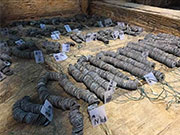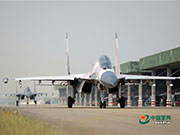

China’s Quest to the West and South
The China’s Indonesia policy is a reflection of its eagerness in realizing its One Belt One Road (OBOR) strategy. After declaring its new policy of OBOR that comprises of two main pillars, namely the Silk Road Economic Belt that placed focus on Central Asia and the 21st Century MSR that place focus on Southeast Asia as the immediate region; the middle power diplomacy with the neighboring countries has gained currency if not more important for China in comparison with great power relations with the pacific powers. The main intention of the project is to enhance connectivity between China, and other Asian, European, and African countries. This project is a further substantiation of China’s two centenary goals that aims to turn China into a “moderately well-off society” by 2020 by doubling its GDP in comparison to 2010 level. This goal is also parallel with the notion of China’s Dream that was put forward by the President Xi that intends to renew the greatness of China as a nation. The above pronouncement has slated to be the key China’s diplomacy in 2015 onwards.
Two Miss Etiquettes stand beside a model of Chinese high-speed rail at the Chinese-backed high-speed rail expo in Jakarta, Indonesia on August 13, 2015.
Being cornered in the Pacific, the policies were attempts of China to pave escape roads from the tumultuous east. China viewed U.S. strategy as the “strategic ring of encirclement” that attempts to surround China’s territory with their influence. Most of the U.S. allies in the Pacific such as Japan, South Korea, the Philippines, and Australia have also attempted to shape a perception that China’s rise is a looming threat and would destabilize the system. However, such view may not necessarily be expressed by countries in the Southeast Asia and the Central Asia, upon which U.S. influence is relatively weak. Although countries in Southeast Asia exercise caution towards China’s rise, they will still very open towards China attempts to increase their foothold in the region as long as it provides a certain amount of benefits.
On the maritime side of the equation , the New Maritime Silk Road is one of the pillars, China has not only been immersing its influence into the Southeast Asia regional architecture, but also intends to strengthen ties with bilateral countries by promising considerable aid to build infrastructure in the Southeast Asia region. One of the more prominent relationships would be with Jakarta that coincides with the ambitious aims of newly elected President Jokowi to build Indonesia’s infrastructure.
This, however, will raise the concerns of countries in the Asia Pacific over the impact of Indonesia’s deepening relationship with China and specifically Indonesia’s ability to maintain its strategic distance with China. It is also raises question on whether China’s middle power diplomacy has an adverse impact on the progress of institution building in the Asia Pacific, particularly ASEAN. During the 60th anniversary of Asian African Conference (ACC) in Bandung on March 2015, Jokowi has openly endorsed China’s initiative of an Asian Infrastructure and Investment Bank (AIIB), while making a pledge to significantly reduce Indonesia’s dependency on the ADB, IMF, and World Bank that was deemed as the United States (U.S.) – led institutions. Not long after the AAC, Xi Jinping and Jokowi signed an agreement worth US$150 bilion that is intended to embark on connectivity projects such as high-speed railway, along with the creation of railway, power plants, and ports, as well as investing in Indonesia’s proposed Special Economic Zones (SECs). Other than indicating the new height of relations between China and Indonesia, this has also signified the ability of China in rallying support from Southeast Asia countries to support its foreign policy goal.
 |  |
Day|Week

 118-meter-high Never-used Building in NW. China Demolished
118-meter-high Never-used Building in NW. China Demolished J-10B fighters with homegrown engine in test flight
J-10B fighters with homegrown engine in test flight 10 tons of copper coins unearthed in 2,000 years old ancient tomb
10 tons of copper coins unearthed in 2,000 years old ancient tomb Beautiful graduate from police college becomes Internet hit
Beautiful graduate from police college becomes Internet hit Photos of U.S. Navy intruding in South China Sea released
Photos of U.S. Navy intruding in South China Sea released What is inside China's icebreaker ‘Xuelong’?
What is inside China's icebreaker ‘Xuelong’? Chinese, U.S. navies hold first-ever joint exercise in the Atlantic
Chinese, U.S. navies hold first-ever joint exercise in the Atlantic In pics: skies of glory
In pics: skies of glory J-10, J-11, Sukhoi Su-30 fighters vs. HQ-9 anti-aircraft missile system
J-10, J-11, Sukhoi Su-30 fighters vs. HQ-9 anti-aircraft missile system Russian plane crash victims sucked out of seats as 'external impact' blew jet apart
Russian plane crash victims sucked out of seats as 'external impact' blew jet apart